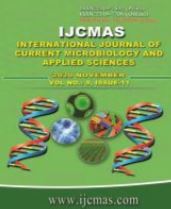


 National Academy of Agricultural Sciences (NAAS)
National Academy of Agricultural Sciences (NAAS)

|
PRINT ISSN : 2319-7692
Online ISSN : 2319-7706 Issues : 12 per year Publisher : Excellent Publishers Email : editorijcmas@gmail.com / submit@ijcmas.com Editor-in-chief: Dr.M.Prakash Index Copernicus ICV 2018: 95.39 NAAS RATING 2020: 5.38 |
The present study was an attempt to increase the fecundity of Jamunapari goats making it comparable to Black Bengal goats. Anestrous Jamunapari does (n=10) were selected those had kidded two to two and half months back and divided into two groups namely JP500 (n=5) and JP1000 (n=10). JP500 and JP1000 groups were primed with 50 mg hydroxy-progesterone caproate and after three days received intra-muscular injection of 500 IU and 1000 IU PMSG respectively. The does were detected for the symptoms of estrus thrice daily. They were administered intra-muscular dose of 250 IU HCG at the onset of estrus. JP (n=5) and BBG (n=5) group constituted Jamunapari and Black Bengal goats those came to estrus naturally and received no treatment. On the tenth day of estrus (day 0 = the day of onset of heat), blood samples were collected from all groups for progesterone assay and the number of corpora lutea counted by trans-rectal ultrasonography. Number of kids born in each group was also recorded. The ovulation rate in Jamunapari does differed significantly with 1000 IU and 500 IU dose of PMSG (5.6 ± 0.6 vs 4.2 ± 0.37 respectively). Black Bengal goats (BBG group) returning to heat naturally had higher ovulation rate than Jamunapari (JP group) goats. The tenth day progesterone concentration of JP500 and JP1000 group was 10.37 ± 0.7 and 12.02 ± 0.8 respectively that did not differ significantly but the values for JP1000 was significantly greater than the non-treated Jamunapari does (JP group; 8.48 ± 0.7). The kidding rate of JP-500 and JP-1000 groups was 2 ± 0.5 and 2.8 ± 0.4 respectively that differed significantly from the non-treated group (group JP; 1.4 ± 0.2) and had non-significant difference between BBG group (2 ± 0.3). Thus from this study it can inferred that the fecundity of Jamunapari does can be successfully increased and made comparable to Black Bengal goats by the treatment of PMSG and HCG.
 |
 |
 |
 |
 |